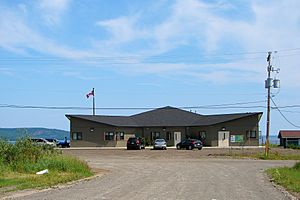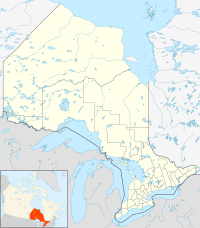Gull Bay First Nation facts for kids
Quick facts for kids
Gull River 55
Kiashke Zaaging
|
|
|---|---|
| Gull River Indian Reserve No. 55 | |
 |
|
| Country | |
| Province | |
| District | Thunder Bay |
| First Nation | Gull Bay |
| Area | |
| • Land | 39.77 km2 (15.36 sq mi) |
| Population
(2021)
|
|
| • Total | 110 |
| • Density | 2.8/km2 (7/sq mi) |
| Time zone | UTC-5 (EST) |
| • Summer (DST) | UTC-4 (EDT) |
Gull Bay First Nation, also known as Kiashke Zaaging Anishinaabek, is a community of Anishinaabe (Ojibway) people. They are a First Nation band government located in northwestern Ontario, Canada. This community is about 175 kilometers (109 miles) north of Thunder Bay, Ontario. You can find it on Ontario Highway 527 on the western shore of Lake Nipigon. In May 2010, there were 1,149 people registered with the First Nation. About 328 of these people lived on their reserve.
Contents
How Gull Bay First Nation is Governed
The Gull Bay First Nation is led by a Chief and 10 Band Council members. These leaders are chosen every four years. They are elected under the First Nations Elections Act. Before 2012, the council had 11 members. It changed to ten members after one council member passed away.
The current Chief is Wilfred King. He first became Chief on January 12, 2013. At that time, his term was for two years. The current councillors are Anthony Esquega, Brian King, Gwendoline King, Hugh King, Kenny King, Kevin King, Wayne King, Hector Murchinson, Roland Poile, Lawrence Shonias Sr, and Marcel Shonias. The next election will happen in November 2020.
Being Part of Larger Groups
Gull Bay First Nation signed the Robinson Superior Treaty in 1850. This means they are part of the Nokiiwin Tribal Council. This council helps different First Nations work together. They are also part of the Union of Ontario Indians. This is a bigger group that speaks for many Anishinaabe First Nations in Ontario. These communities are located around Lake Superior and Lake Huron.
Switching to Solar Power
In August 2019, something exciting happened. The community stopped using its old diesel electric generator during the day. It had been running for 60 years! Instead, they started getting power from a new solar panel system. This is a big step towards using cleaner energy. Diesel is still used at night when the sun isn't shining.
Chiefs of Gull Bay First Nation
- Wilfred King (December 14, 2000 to December 10, 2022)
- Miles Nowegejick (December 10, 2010 to January 12, 2013)
- Wilfred King (January 12, 2013 to present)
Gull River 55 Reserve
The Gull Bay First Nation has its own special land called the Gull River 55 Indian Reserve. This reserve is about 3,940 hectares (9,736 acres) in size. The community of Gull Bay is located on this reserve.
History of the Reserve
The reserve was created in 1850 as part of the Robinson Superior Treaty. In the same year, the Hudson's Bay Company (HBC) moved its trading post here. A trading post was a place where people traded goods. This post was moved from Wabinosh Bay, which was about 16 kilometers (10 miles) north on Lake Nipigon.
The trading post was known as Nipigon or Fort Nipigon. It also had a smaller outpost in Red Rock (now called Nipigon) from 1864 to 1871. From 1881 to 1892, it was the main office for the Nipigon District. In 1900, the post was renamed Nipigon House. This was to avoid confusion with Red Rock, which was then called Nipigon. It was renamed again in 1954 to Gull Bay.
In 1959, the post became part of the HBC Northern Stores Department. It operated as a "Northern Store" until it closed in 1972.
Land Claims and Agreements
Reserve Size Issue
When the Robinson Superior Treaty was signed, the First Nations people did not know what a "mile" was. They thought it meant a "league," which is a much larger distance. The treaty said each band would get 16 square miles of land. This was much smaller than what the First Nations expected.
As soon as they realized the mistake, the First Nations told the government. Surveyors fixed the problem for most reserves. However, a few reserves, like Gull Bay First Nation, were considered too far away. Because of this, Gull Bay First Nation officially asked the Canadian government to fix the size of their reserve in 2016.
Timber Rights Settlement
In 2016, the community also voted to accept a settlement from the government. This settlement was for 8.1 million dollars. It was about money they should have received from timber (wood) cut on their reserve.



